Photodiode Power Sensors (C-Series)
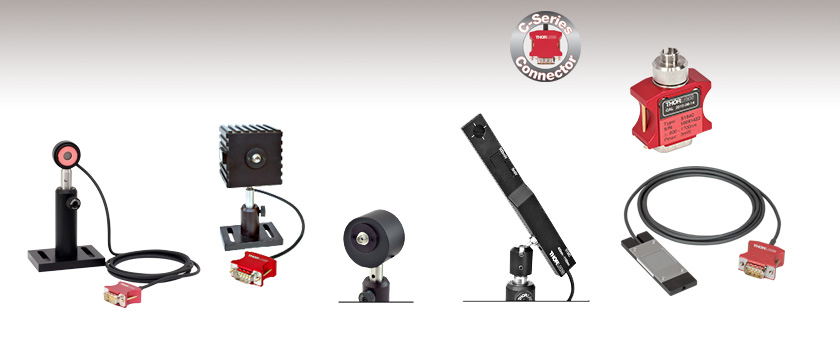
- Power Ranges Covering 100 pW to 20 W
- Wavelength Ranges Covering 200 nm to 5.5 µm
- C-Series Connector for Quick Exchange
S120C
Sensor with IR
Target
S145C
Integrating Sphere Sensor
Posts and Post Holders Not Included
S140C
Integrating Sphere Sensor
S130C
Slim Sensor
S154C
Fiber Sensor
S170C
Microscope Slide
Power Sensor Head
Integrating Sphere Sensors Shown with Included FC/PC Adapters
Articulating Arm Not Included

Please Wait
| Power Meter Selection Guide |
|---|
| Sensors |
| Photodiode Power Sensors |
| Thermal Power Sensors |
| Thermal Position & Power Sensors |
| Pyroelectric Energy Sensors |
| Power Meter Consoles |
| Digital Handheld Console |
| Analog Handheld Console |
| Touchscreen Handheld Console |
| Dual-Channel Benchtop Console |
| Complete Power Meters |
| Power Meter Bundles |
| Wireless Power Meters with Sensors |
| Compact USB Power Meters |
| Field Power Meters for Terminated Fibers |
| USB Interfaces, External Readout |
Features
- Fast Response Time and High Resolution
- C-Series Connector Design for Quick Sensor Connection
- Over-Temperature Alert Sensor (Except S130 Series and S170C Microscope Slide Sensor)
- Individually Calibrated with NIST- or PTB-Traceable Certificate of Calibration Plus Embedded Calibration Curve and Sensor Settings
Thorlabs' C-Series Photodiode Power Meter Sensors cover a wide power and wavelength range. These sensors are offered in standard, slim, microscope slide, integrating sphere, and compact fiber versions to meet your specific application requirements. They are the best sensor choice when a fast response time or high resolution is required and there is not a need for a flat spectral response.
These photodiode power meter sensors feature enhanced shielding to avoid electromagnetic interference as well as an over-temperature alert sensor to warn against damage and measurement errors due to overheating of the sensor (except the S130C Series Slim Sensors and the S170C Microscope Slide Sensor). For all sensors (except the S130C Slim Sensors and the S170C Microscope Slide Sensor), a set of fiber adapters is available to connect them to standard optical fiber patch cables (see below). Other fiber adapter types are available upon request.
The sensors below (except the S150C series) have universal 8-32 and M4 taps for mounting to Ø1/2" Posts. Posts and post holders are not included and sold separately.
Compatibility
The Photodiode Sensors presented here are compatible with C-Series power meter consoles including the PM400, PM100D, PM100A, PM100USB, and PM320E. The S150C Series Fiber Sensors are integrated into the connector itself and directly plugged into the console.
Calibration
Each sensor head is individually calibrated and is shipped with NIST- or PTB-traceable calibration data. The included data will match the calibration certification of the photodiode used to test the individual sensor. The calibration and identification data is stored in the connector of the sensor and is downloaded automatically to the connected power meter console.
Thorlabs offers specific recalibration services for all our photodiode power sensors. To ensure accurate measurements, we recommend recalibrating the sensors annually. To order this service, scroll toward the bottom of the page and select the appropriate Item # that corresponds to your power sensor. For questions and pricing information pertaining to this service, please contact Tech Support.
Sensor Upgrade Service
All C-Series Sensors are incompatible with old power meter consoles with non-C-Series connectors. We offer a sensor upgrade service if you want to use your existing sensors with a new power meter console with C-Series connector. Note: upgraded sensors will be incompatible with old power meter consoles with non-C-Series connectors. Please contact our Tech Support team for details.
Recalibration Service
Recalibration services are available for these photodiode power sensors. To order this service, scroll to the bottom of the page and select the appropriate Item # that corresponds to your sensor.
| Photodiode Sensor Selection Guide | |||||
|---|---|---|---|---|---|
| Housing Type | Standard | Slim | Microscope Slide | Integrating Sphere | Fiber-Coupled |
| Power Range | 50 nW - 500 mW | 500 pW - 500 mW | 10 nW - 150 mW | 1 µW - 20 W | 100 pW - 20 mW |
| Wavelength Range | 200 - 1800 nm | 200 - 1800 nm | 350 - 1100 nm | 350 - 5500 nm | 350 - 1700 nm |
| Typical Application | General Measurement | Tight Places | Microscope Alignment and Calibration | Divergent Beams | Fiber |
| Fiber Adapters Available | Yes | Yes | No | Yes | Yes |
These specifications were obtained at an ambient room temperature of 23 °C ± 0.5 °C and a humidity of 45% ± 15%.
Standard Photodiode Sensors: S120C Series
| Item # | S120VC | S120C | S121C | S122Ca |
|---|---|---|---|---|
| Technical Specs | ||||
| Detector Type | Silicon Photodiode (UV Extended) | Silicon Photodiode | Silicon Photodiode | Germanium Photodide |
| Wavelength Range | 200 nm - 1100 nm | 400 nm - 1100 nm | 400 nm - 1100 nm | 700 nm - 1800 nm |
| Optical Power Range | 50 nW - 50 mW | 50 nW - 50 mW | 500 nW - 500 mW | 50 nW - 40 mW |
| Max Average Power Densityb | 20 W/cm² | 10 W/cm² | ||
| Max Pulse Energy | 20 µJ | |||
| Linearity | ±0.5% | |||
| Resolutionc | 1 nW | 1 nW | 10 nW | 2 nW |
| Measurement Uncertaintyd | ±3% (440 - 980 nm) ±5% (280 - 439 nm) ±7% (200 - 279 nm, 981 - 1100 nm) |
±3% (440 - 980 nm) ±5% (400 - 439 nm) ±7% (981 - 1100 nm) |
±3% (440 - 980 nm) ±5% (400 - 439 nm) ±7% (981 - 1100 nm) |
±5% |
| Responsivitye (Click for Details) | Raw Data |
Raw Data |
Raw Data |
Raw Data |
Slim Profile Photodiode Sensors: S130C Series
| Item # | S130VC | S130C | S132Ca |
|---|---|---|---|
| Technical Specs | |||
| Detector Type | Silicon Photodiode (UV Extended) |
Silicon Photodiode | Germanium |
| Wavelength Range | 200 nm - 1100 nm | 400 nm - 1100 nm | 700 nm - 1800 nmb |
| Optical Power Range (with Filter) |
500 pW - 0.5 mWc (Up to 50 mW)c |
500 pW - 5 mW (Up to 500 mW) |
5 nW - 5 mW (Up to 500 mW) |
| Max Average Power Densityd |
20 W/cm² | 10 W/cm² | |
| Max Pulse Energy | 20 µJ | ||
| Linearity | ±0.5% | ||
| Resolution | 100 pWe | 100 pWe | 1 nWf |
| Measurement Uncertaintyg |
±3% (440 - 980 nm) ±5% (400 - 439 nm) ±7% (200 - 279 nm, 981 - 1100 nm) |
±3% (440 - 980 nm) ±5% (280 - 439 nm) ±7% (981 - 1100 nm) |
±5% |
| Responsivityh (Click for Details) | Raw Data |
Raw Data |
Raw Data |
Microscope Slide Photodiode Sensor
| Item # | S170C | ||
|---|---|---|---|
| Technical Specs | |||
| Detector Type | Silicon Photodiode | ||
| Wavelength Range | 350 - 1100 nm | ||
| Optical Power Working Range |
10 nW - 150 mW | ||
| Max Average Power Densitya |
20 W/cm² | ||
| Max Pulse Energy | N/A | ||
| Linearity | ±0.5% | ||
| Resolutionb | 1 nW | ||
| Calibration Uncertaintyc |
±3% (440 - 980 nm) ±5% (350 - 439 nm) ±7% (981 - 1100 nm) |
||
| Responsivityd (Click for Details) | Raw Data |
||
Integrating Sphere Photodiode Sensors
| Item # | S140C | S142C | S144C | S145C | S146C | S148C | S180C |
|---|---|---|---|---|---|---|---|
| Technical Specs | |||||||
| Detector Type | Si Photodiode | InGaAs Photodiode | HgCdTe (MCT) Photodiode | ||||
| Wavelength Range | 350 nm - 1100 nm | 800 nm - 1700 nm | 900 nm - 1650 nm | 1200 - 2500 nm | 2900 - 5500 nm | ||
| Optical Power Range | 1 µW - 500 mW | 1 µW - 5 W | 1 µW - 500 mW | 1 µW - 3 W | 10 µW - 20 W | 1 µW - 1 W | 1 µW - 3 W |
| Max Average Power Densitya |
1 kW/cm² | 2 kW/cm² | 1 kW/cm² | 2 kW/cm² | 1 kW/cm² | ||
| Max Pulse Energy Density |
1 J/cm² | 7 J/cm² | 1 J/cm² | 7 J/cm² | 1 J/cm² | ||
| Linearity | ±0.5% | ||||||
| Resolutionb | 1 nW | 10 nW | 1 nW | 10 nW | |||
| Measurement Uncertaintyc |
±3% (440 - 980 nm) ±5% (350 - 439 nm) ±7% (981 - 1100 nm) |
±5% | |||||
| Responsivityd (Click for Plot) |
Raw Data |
Raw Data |
Raw Data |
Raw Data |
Raw Data |
Raw Data |
Raw Data |
Fiber-Coupled Photodiode Sensors: S150C Series
| Item # | S150C | S151C | S154C | S155C |
|---|---|---|---|---|
| Technical Specs | ||||
| Detector Type | Si Photodiode | InGaAs Photodiode | ||
| Wavelength Range | 350 nm - 1100 nm | 400 nm - 1100 nm | 800 nm - 1700 nm | 800 nm - 1700 nm |
| Optical Power Range | 100 pW - 5 mW (-70 dBm to 7 dBm) |
1 nW - 20 mW (-60 dBm to 13 dBm) |
100 pW - 3 mW (-70 dBm to 5 dBm) |
1 nW - 20 mW (-60 dBm to 13 dBm) |
| Max Average Power Densitya | 100 mW/cm² | 10 W/cm² | 100 mW/cm² | 10 W/cm² |
| Max Pulse Energy | 20 µJ | |||
| Linearity | ±0.5% | |||
| Resolutionb | 10 pW (-80 dBm) | 100 pW (-70 dBm) | 10 pW (-80 dBm) | 100 pW (-70 dBm) |
| Measurement Uncertaintyc | ±3% (440 - 980 nm) ±5% (350 - 439 nm) ±7% (981 - 1100 nm) |
±3% (440 - 980 nm) ±5% (400 - 439 nm) ±7% (981 - 1100 nm) |
±5% | |
| Responsivityd (Click for Details) | Raw Data |
Raw Data |
Raw Data |
Raw Data |
Sensor Connectors
D-Type Male

| Pin | Connection | |
|---|---|---|
| S120, S140, and S150 Series, S170C, and S180C Sensors | S130 Series Sensors | |
| 1 | Not Used | |
| 2 | EEPROM Data | |
| 3 | Photodiode Anode and NTC Ground | Photodiode Anode |
| 4 | Photodiode Cathode | |
| 5 | Not Used | |
| 6 | EEPROM Ground | |
| 7 | NTC | Slider Detection |
| 8 | Not Used | |
| 9 | Not Used | |
Pulsed Laser Emission: Power and Energy Calculations
Determining whether emission from a pulsed laser is compatible with a device or application can require referencing parameters that are not supplied by the laser's manufacturer. When this is the case, the necessary parameters can typically be calculated from the available information. Calculating peak pulse power, average power, pulse energy, and related parameters can be necessary to achieve desired outcomes including:
- Protecting biological samples from harm.
- Measuring the pulsed laser emission without damaging photodetectors and other sensors.
- Exciting fluorescence and non-linear effects in materials.
Pulsed laser radiation parameters are illustrated in Figure 1 and described in the table. For quick reference, a list of equations are provided below. The document available for download provides this information, as well as an introduction to pulsed laser emission, an overview of relationships among the different parameters, and guidance for applying the calculations.
|
Equations: |
||||
 |
and |  |
||
 |
||||
 |
||||
 |
||||
Peak power and average power calculated from each other: |
||||
 |
and |  |
||
| Peak power calculated from average power and duty cycle*: | ||||
 |
*Duty cycle ( ) is the fraction of time during which there is laser pulse emission. ) is the fraction of time during which there is laser pulse emission. |
|||

Click to Enlarge
Figure 1: Parameters used to describe pulsed laser emission are indicated in the plot (above) and described in the table (below). Pulse energy (E) is the shaded area under the pulse curve. Pulse energy is, equivalently, the area of the diagonally hashed region.
| Parameter | Symbol | Units | Description | ||
|---|---|---|---|---|---|
| Pulse Energy | E | Joules [J] | A measure of one pulse's total emission, which is the only light emitted by the laser over the entire period. The pulse energy equals the shaded area, which is equivalent to the area covered by diagonal hash marks. | ||
| Period | Δt | Seconds [s] | The amount of time between the start of one pulse and the start of the next. | ||
| Average Power | Pavg | Watts [W] | The height on the optical power axis, if the energy emitted by the pulse were uniformly spread over the entire period. | ||
| Instantaneous Power | P | Watts [W] | The optical power at a single, specific point in time. | ||
| Peak Power | Ppeak | Watts [W] | The maximum instantaneous optical power output by the laser. | ||
| Pulse Width |  |
Seconds [s] | A measure of the time between the beginning and end of the pulse, typically based on the full width half maximum (FWHM) of the pulse shape. Also called pulse duration. | ||
| Repetition Rate | frep | Hertz [Hz] | The frequency with which pulses are emitted. Equal to the reciprocal of the period. | ||
Example Calculation:
Is it safe to use a detector with a specified maximum peak optical input power of 75 mW to measure the following pulsed laser emission?
- Average Power: 1 mW
- Repetition Rate: 85 MHz
- Pulse Width: 10 fs
The energy per pulse:

seems low, but the peak pulse power is:

It is not safe to use the detector to measure this pulsed laser emission, since the peak power of the pulses is >5 orders of magnitude higher than the detector's maximum peak optical input power.
Thorlabs offers a wide selection of power and energy meter consoles and interfaces for operating our power and energy sensors. Key specifications of all of our power meter consoles and interfaces are presented below to help you decide which device is best for your application. We also offer self-contained wireless power meters and compact USB power meters.
When used with our C-series sensors, Thorlabs' power meter consoles and interfaces recognize the type of connected sensor and measure the current or voltage as appropriate. Our C-series sensors have responsivity calibration data stored in their connectors. The console will read out the responsivity value for the user-entered wavelength and calculate a power or energy reading.
- Photodiode sensors deliver a current that depends on the input optical power and the wavelength. The current is fed into a transimpedance amplifier, which outputs a voltage proportional to the input current. The photodiode's responsivity is wavelength dependent, so the correct wavelength must be entered into the console for an accurate power reading. The console reads out the responsivity for this wavelength from the connected sensor and calculates the optical power from the measured photocurrent.
- Thermal sensors deliver a voltage proportional to the input optical power. Based on the measured sensor output voltage and the sensor's responsivity, the console will calculate the incident optical power.
- Energy sensors are based on the pyroelectric effect. They deliver a voltage peak proportional to the pulse energy. If an energy sensor is recognized, the console will use a peak voltage detector and the pulse energy will be calculated from the sensor's responsivity.
The consoles and interfaces are also capable of providing a readout of the current or voltage delivered by the sensor. Select models also feature an analog output.
Consoles
| Item # | PM100A | PM100D | PM400 | PM320E |
|---|---|---|---|---|
| (Click Photo to Enlarge) |  |
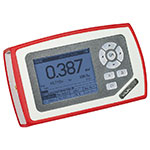 |
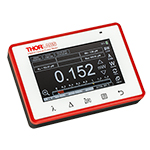 |
 |
| Key Features | Analog Power Measurements | Digital Power and Energy Measurements | Digital Power and Energy Measurements, Touchscreen Control | Dual Channel |
| Compatible Sensors | Photodiode and Thermal Power | Photodiode and Thermal Power; Pyroelectric | ||
| Housing Dimensions (H x W x D) |
7.24" x 4.29" x 1.61" (184 mm x 109 mm x 41 mm) |
7.09" x 4.13" x 1.50" (180 mm x 105 mm x 38 mm) |
5.35" x 3.78" x 1.16" (136.0 mm x 96.0 mm x 29.5 mm) |
4.8" x 8.7" x 12.8" (122 mm x 220 mm x 325 mm) |
| Channels | 1 | 2 | ||
| External Temperature Sensor Input (Sensor not Included) | - | - | Instantaneous Readout and Record Temperature Over Time | - |
| External Humidity Sensor Input (Sensor not Included) | - | - | Instantaneous Readout and Record Humidity Over Time | - |
| GPIO Ports | - | 4, Programmable | - | |
| Source Spectral Correction | - | - | - | |
| Attenuation Correction | - | - | - | |
| External Trigger Input | - | - | - | |
| Display | ||||
| Type | Mechanical Needle and LCD Display with Digital Readout | 320 x 240 Pixel Backlit Graphical LCD Display | Protected Capacitive Touchscreen with Color Display | 240 x 128 Pixels Graphical LCD Display |
| Dimensions | Digital: 1.9" x 0.5" (48.2 mm x 13.2 mm) Analog: 3.54" x 1.65" (90.0 mm x 42.0 mm) |
3.17" x 2.36" (81.4 mm x 61.0 mm) |
3.7" x 2.1" (95 mm x 54 mm) |
3.7" x 2.4" (94.0 mm x 61.0 mm) |
| Refresh Rate | 20 Hz | 10 Hz (Numerical) 25 Hz (Analog Simulation) |
20 Hz | |
| Measurement Viewsa | ||||
| Numerical | ||||
| Mechanical Analog Needle | - | - | - | |
| Simulated Analog Needle | - | |||
| Bar Graph | - | |||
| Trend Graph | - | |||
| Histogram | - | - | ||
| Statistics | ||||
| Memory | ||||
| Type | - | SD Card | NAND Flash | - |
| Size | - | 2 GB | 4 GB | - |
| Power | ||||
| Battery | LiPo 3.7 V 1300 mAh | LiPo 3.7 V 2600 mAh | - | |
| External | 5 VDC via USB or Included AC Adapter | 5 VDC via USB | Selectable Line Voltage: 100 V, 115 V, 230 V (±10%) | |
Interfaces
| Item # | PM101 | PM102 | PM101A | PM102A | PM101R | PM101U | PM102U | PM100USB |
|---|---|---|---|---|---|---|---|---|
| (Click Photo to Enlarge) |  |
 |
 |
 |
 |
 |
 |
 |
| Key Features | USB, RS232, UART, and Analog Operation |
USB and Analog SMA Operation | USB and RS232 Operation | USB Operation | USB Operation | |||
| Compatible Sensors | PM101 Series: Photodiode and Thermal Power PM102 Series: Thermal Power and Thermal Position & Power |
Photodiode and Thermal Power; Pyroelectric |
||||||
| Housing Dimensions (H x W x D) |
3.80" x 2.25" x 1.00" (96.5 x 57.2 x 25.4 mm) |
3.94" x 2.25" x 1.00" (100.0 x 57.2 x 25.4 mm) |
3.78" x 2.25" x 1.00" (95.9 x 57.2 x 25.4 mm) |
3.68" x 2.25" x 1.00" (93.6 x 57.2 x 25.4 mm) |
3.67" x 2.38 " x 1.13" (93.1 x 60.4 x 28.7 mm) |
|||
| Channels | 1 | |||||||
| External Temperature Sensor Input (Sensor Not Included) |
NTC Thermistor | - | ||||||
| External Humidity Sensor Input (Sensor not Included) |
- | |||||||
| GPIO Ports | - | |||||||
| Source Spectral Correction | - | |||||||
| Attenuation Correction | - | |||||||
| External Trigger Input | - | |||||||
| Display | ||||||||
| Type | No Built-In Display; Controlled via GUI for PC | |||||||
| Refresh Rate | Up to 1000 Hza | Up to 300 Hza | ||||||
| Measurement Viewsb | ||||||||
| Numerical | Requires PCb | |||||||
| Mechanical Analog Needle | - | |||||||
| Simulated Analog Needle | Requires PCb | |||||||
| Bar Graph | Requires PCb | |||||||
| Trend Graph | Requires PCb | |||||||
| Histogram | Requires PCb | |||||||
| Statistics | Requires PCb | |||||||
| Memory | ||||||||
| Type | Internal Non-Volatile Memory for All Settings | - | ||||||
| Size | - | |||||||
| Power | ||||||||
| Battery | - | |||||||
| External | 5 VDC via USB or 5 to 36 VDC via DA-15 |
5 VDC via USB | ||||||
| Posted Comments: | |
Chang Jeremy
(posted 2020-11-06 00:31:58.187) Hello
I want to understand how to calculate the standard deviation in the power meter. I did a program to control PM100D and I calculated standard deviation by calculating mean power with common method on Wiki;however, the value I calculate is 10 times than the value Power meter showed. Please give a hand. Thanks!
Best, Jeremy dpossin
(posted 2020-11-10 10:47:13.0) Dear Jeremy,
Thank you for your feedback. The standard deviation is calculated on the fly. I am reaching out to you in order to provide the relevant algorithm we use to calculate the standard deviation. user
(posted 2020-10-17 10:14:25.98) I have a photodiode S132C, I measure the photocurrent by transimpedance amplifier and next lock-in at 0V bias. I need to determine the power density of the light out from the monochromator. What area do I need to take to right calculate power density, the active detector area, or beam size? MKiess
(posted 2020-10-19 10:38:08.0) Thank you very much for your inquiry. To measure the power density, you should use the beam size incident on the sensor. pao chen
(posted 2020-09-14 13:37:16.15) I have 2 units of S120VC working with 2 PM100D meters.
However, I leant that the reading of S120VC is about 55%~ 60% of that measured by various SiC sensors at 265nm and 275nm.
It is significant to determine which reading is correct in UV measurement. Can you please provie your opinion on this matter? MKiess
(posted 2020-09-15 04:55:14.0) Thank you very much fo your inquiry. If the sensor is currently calibrated and the wavelength and power range settings on the Power Meter are correct, the S120VC should have a maximum measurement uncertainty of ±7% in this wavelength range.
I have contacted you directly to discuss your measurement results in detail. Michal Pelach
(posted 2020-07-09 08:41:26.2) Is it possible to get sensor calibration data at 785 nm? MKiess
(posted 2020-07-10 08:29:39.0) This is a response from Michael at Thorlabs. Each S120VC is individually calibrated before delivery. Therefore the values are slightly different for each sensor. The typical value for the responsivity of the S120VC at 785nm is 35.69mA/W. I have contacted you directly to discuss the exact details for your sensor. li bo
(posted 2020-06-16 21:01:29.83) 积分球传感器里面脏了,怎么清理呢 wskopalik
(posted 2020-06-17 10:26:09.0) This is a response from Wolfgang at Thorlabs. Thank you very much for your inquiry.
The question is how integrating sphere sensors like the S142C can be cleaned. The housing may be cleaned by wiping with a soft damp cloth. The integrating sphere inner surface however cannot be cleaned and should not be touched. You can gently blow off any debris using compressed air. If this does not remove all the dirt or dust in the sphere, the sphere will probably need to be exchanged so you would need to send the sensor in for a repair.
Our Tech Support team in China will reach out to you directly. 達也 真藤
(posted 2020-04-16 21:52:55.94) 積分球パワーセンサS146Cについて、スペックシートにMax Pulse Energy Density 7 J/cm²との記載があったが、これはレーザの1周期中に放射される1パルスの全放射エネルギーを意味している、という解釈で良いか確認させて頂きたい。 MKiess
(posted 2020-04-20 05:26:42.0) お問合せをありがとうございました。ソーラボジャパンの技術サポートから直接回答をいたします。 xinxin peng
(posted 2020-04-10 16:55:13.01) 应用太有限,我们希望底部有个M4的螺孔,用支柱用于各种光路系统中,希望采纳。 YLohia
(posted 2020-04-10 09:40:01.0) Thank you for contacting Thorlabs. An applications engineer from our Tech Support team in China will reach out to you directly. user
(posted 2020-02-25 10:34:47.983) Hi,
I'm using the S130C to measure the power of a beam, either collimated, divergent or focused. Is it normal to have different power values depending on whether the beam covers a large fraction of the detector's surface (case of collimated beam) or covers a small surface (focused beam)?
Thank you for your help
Best nreusch
(posted 2020-02-27 09:02:08.0) This is a response from Nicola at Thorlabs. Thank you very much for your feedback! S130C comes with a Si photodiode. Photodiodes in general are sensitive to the angle of incidence. So for focused and divergent beams, you will always have parts of the beam that will not hit the sensor at a right angle, which will affect the measurement. Photodiode sensors will also not show a completely uniform response over their active area. Therefore, the specified measurement uncertainty is only valid for beam diameters larger than 1 mm. You should also take care to not overfill the sensor with a divergent beam. We will contact you directly to discuss your specific application in more detail. Matthew Kirchner
(posted 2019-11-25 13:24:07.727) Hi, does the S142C correct for temperature dependence of the Si photodiode responsivity? dpossin
(posted 2019-11-27 08:43:20.0) Dear Customer,
Thank you for your feedback. The S142C does not compensate temperature effects of the sensor automatically. However it is possible to compensate
the temperature dependent dark current with our powermeter consoles. I am reaching out to you to provide further information on that. user
(posted 2019-11-15 12:57:48.94) Dear Thorlabs,
We are considering ordering one of your products to measure the average power of a scanned pulsed laser, that reaches an aperture of a few mm, with the following parameters:
» Beam width: 1 mm
» Wavelength: 1,5 micron
» Pulse energy: 1 micro-Joule
» Pulse duration: 1 nW
The pulse train incident on the opening depends on its diameter as well as the scanning parameters:
» Repetition frequency: minimum 10 Hz (frame rate); maximum 1MHz (pulse repetition rate)
» Average power on aperture: typical 10 mW; minimum 10 micro-W; maximum 1 W (static beam).
Which kind of power meter do you recommend for the described application: a photo-diode/integrating sphere or a thermopile?
Sincerely,
Flávio Ferreira
-----
University of Minho
Department of Physics MKiess
(posted 2019-11-18 06:12:44.0) This is a response from Michael at Thorlabs. Thank you for the inquiry. Depending on the pulse duration, repetition rate, laser power and the general conditions of your application, a thermal sensor or a photodiode sensor may be suitable for you. In order to be able to use this optimally, different conditions have to be fulfilled depending on the sensor type. Details can be found under the following link:
https://www.thorlabs.de/newgrouppage9.cfm?objectgroup_id=6188&tabname=%20Sensor%20Selection
I contacted you directly to discuss further details and select the most suitable sensor together with you. Karim Elkhouly
(posted 2019-10-23 07:39:14.07) I am considering using an integrated sphere for calibrated EQE measurements of LEDs. I am wondering what is the fundamental difference between standard power meters like the S120VC and ones for integrating spheres. Especially that the minimum detectable power is much higher in the latter option. Can I use S120VC with integrating sphere for example ? MKiess
(posted 2019-10-28 11:09:54.0) This is a response from Michael at Thorlabs. Thank you for the inquiry. The radiation scattered in the integrating sphere is almost ideally diffuse over the specified spectrum. This allows on the one hand to measure a photometric standard and on the other hand to measure the power or the total radiation flux of different light sources, independent of beam uniformity, divergence, beam shape and entrance angle, making them excellent for use with fiber sources and off-axis free space sources.
Due to the diffusivity, the power range is also higher than that of the sensors with which the radiation is measured directly, such as the S120VC.
These are therefore better suited for measurements of collimated beams with small powers.
I have contacted you directly to select the most suitable sensor for your application together. Andrey Kuznetsov
(posted 2019-07-12 15:15:12.757) S12X series photodiodes have a poorly modeled solidworks file, can you update the model to reflect the internal size and position of the photodiode. While the aperture is 9.5mm, the aperture appears to be 3.3mm from the photodiode based on PDF drawing. This means that when measuring divergent light, if the photodiode is not large enough to collect all the light passing through the 9.5mm aperture then the measurement will be wrong. A +-45 degree light passing through a 9.5mm aperture with detector at 3.3mm away from aperture will expand the minimum radius of the photodiode by 3.3mm to 16.1mm diameter. wskopalik
(posted 2019-07-23 10:33:46.0) This is a response from Wolfgang at Thorlabs. Thank you very much for your inquiry!
It is generally not recommended to measure strongly divergent beams with a S12X series sensor. One reason is - as you have mentioned - that it is difficult to make sure that all the light is collected by the photodiode. In addition, photodiodes also show a dependence of the responsivity with respect to the angle of incidence. So these sensors are not ideal.
For a divergent beam e.g. the sensors of the S14X series would be much more suitable. These have an integrating sphere which makes the collection of the light easier and which also ensures that the light is shining on the photodiode perpendicularly.
I will contact you directly regarding these sensors and the drawings. Andrey Kuznetsov
(posted 2019-07-09 11:39:03.727) Please update the Drawing for S122C, it points to a PDF that includes other photodiodes and does not explicitly mention S122C anywhere. mmcclure
(posted 2019-07-11 08:16:35.0) Hello, thank you for bringing this to our attention. We have added the S122C-specific PDF drawing on the webpage. user
(posted 2019-07-03 19:19:41.117) Can Thorlabs improve the calibration uncertainty from 3% to 1%? This is the major sticking point when considering Thorlabs photodiodes for use in precise calibration systems where 0.5% errors matter. dpossin
(posted 2019-07-05 10:34:27.0) Dear customer,
Thank you for your feedback. Unfortunately we can not specify an uncertainty of 1% over the full spectral range. Our references are calibrated by PTB or NIST and have an uncertainty of 0.3% up to 1.5% with respect to the wavelength. If we take into account the expanded uncertainty trough the reference and the calibration Setup, we get an Overall uncertainty of 2% for silica based sensors and 3% for germanium based sensors. user
(posted 2019-06-19 11:51:29.203) Could you use the same ND filter that you used for the S121C Silicon head so as to allow this Ge head to measure up to 500mW?
We could really use a Ge head that measures up to 500 mW. wskopalik
(posted 2019-06-21 09:57:17.0) This is a response from Wolfgang at Thorlabs. Thank you very much for your inquiry!
We should be able to offer this as a custom version. I will contact you directly regarding your requirements. Alternatively, you could also use the S132C which has a Ge photodiode and can measure up to 500mW or also the S144C which has an InGaAs photodiode. On the S144C the wavelength range is slightly different, but you can also measure up to 500mW. user
(posted 2019-05-01 13:02:36.09) The strain relief for the cable exiting the 9 way D connector head-shell is inadequate. From active use in the lab, the flexing has broken the outer sheath and is putting strain onto the inner conductors. I have had to effect an interim repair - can send you pics if you contact me. wskopalik
(posted 2019-05-02 07:47:21.0) This is a response from Wolfgang at Thorlabs. Thank you very much for your feedback!
I'm sorry to hear about this issue with your sensor. I will contact you directly so you can send me pictures of the defective cable. I'm sure that we will find a good solution in this case. Fabian Röser
(posted 2019-04-09 04:02:07.897) Dear Sir/Madam,
when measuring the average power of a pulsed system with a S145C integrating sphere, I noticed that the response is strongly dependend on the actual repetition rate of the pulse train. Measuring at 50kHz shows only a fraction of the average power.
Could you please specify the repetition frequency band of quasi-cw signals in which these Sensors can be used? Also, can they be modified to work with repetion rates in the kHz range?
Thanks in advance nreusch
(posted 2019-04-16 06:16:03.0) This is a response from Nicola at Thorlabs. Thank you for your inquiry. The behavior that you observed results from the combination of the rise and fall times of the photodiode as well as the electronic bandwidths of amplifiers and converters of the readout circuits. I recommend using a thermal power head in order to measure the average power of a pulsed system. I will contact you directly to discuss different options for your application. yongqi.shi
(posted 2019-01-30 09:26:44.323) Dear Sir/Madam, I'm using S130C power sensor. When I use the filter to measure the optical power around 28mW, I found that the there's always a 15% to 20% deviation when change the incident angle of the beam from -20 deg to 20 deg. What would be the reason and how to get a more precise measurement? Thank you in advance. wskopalik
(posted 2019-02-04 10:51:28.0) This is a response from Wolfgang at Thorlabs. Thank you very much for your inquiry!
The ideal case for photodiode sensors is if the beam hits the photodiode and the filter perpendicularly. This is how the sensors are calibrated so the accuracy is the highest in this case. The responsivity of photodiodes as well as the attenuation of filters depend on the angle of incidence. This means that the displayed power readings will change if the angle of incidence is changed. Thermal power sensors are more suitable for applications in which the angle changes because they have much less dependence on the angle of incidence.
I will contact you directly to provide further assistance. user
(posted 2019-01-23 13:11:44.777) Dear Sir. Is it possible to use two Powermeter S121 at the same time with the same software on PC?Now I only can choose one USB-connection at the software. wskopalik
(posted 2019-04-05 11:02:09.0) This is a response from Wolfgang at Thorlabs. Thank you very much for your feedback!
Yes, it is possible to operate up to eight power meters simultaneously in the power meter software. You would need a power meter for each sensor which you want to operate in the software. Maybe there is an issue with one of these connections. It is however hard to tell without further details.
Unfortunately, you didn't leave any contact details in the feedback so I cannot contact you directly. Please feel free to contact me any time at europe@thorlabs.com. abc124771
(posted 2019-01-21 17:01:19.24) What does 'max. avg. power density' of 20W/cm2 signify? Does it mean it can withstand 20W? Or is the max. power it can withstand given by the range which is 500mW for S130C? swick
(posted 2019-01-25 04:11:07.0) This is a response from Sebastian at Thorlabs. Thank you for the inquiry. The max. average power density represents the damage threshold of the sensor. dietrich
(posted 2018-12-13 10:50:27.293) Dear, Sir. We want to measure light which is more or less broadband with a wavelength of 1900 to 2300 nm in the power range from 1 mW to 1 W. Unfortunaly your detector S148C has in this area strong nonlinearities. Is it possible that you replace the build in photo diode with a different one like extended InGaAs with a cutoff wavelength of 2.6 μm?
With best Regards Christian Markus Dietrich nreusch
(posted 2018-12-19 02:22:17.0) This is a response from Nicola at Thorlabs. Thank you very much for your inquiry. Yes, we can offer customized versions of our integration spheres with different diodes. I will contact you directly to discuss further details. aSadykov
(posted 2018-07-17 09:55:31.477) Dear, Sir.
Datasheet for S122C include parameter -"Measurement Uncertainty" which is equal to "+/- 5%".
and collibration has been made in accordiance with NIST.
I'd like to make clear "Measuremet Uncertainty" in data sheet is "Standard measurement uncertainty" or something else.
https://www.nist.gov/itl/sed/topic-areas/measurement-uncertainty
With best Reguards
Andrey Sadykov nreusch
(posted 2018-07-20 10:17:17.0) This is a response from Nicola at Thorlabs. Thank you for your inquiry! Your assumption is correct. The "Measurement Uncertainty" specification corresponds to the "Standard Measurement Uncertainty" as defined by NIST. jhamilton
(posted 2018-05-30 13:19:00.957) Can you please provide me with operational temperature range for the S122. Can you also provide me with RoHS status.
Thank you mvonsivers
(posted 2018-06-05 05:15:09.0) This is a response from Moritz at Thorlabs. Thank you for your inquiry. The RoHS declaration can be found by clicking on the red document button next to the product number. The sensors are calibrated at room temperature, operating them at other temperatures will reduce the accuracy of the measurement. cyprien.lanthermann
(posted 2018-04-19 16:09:31.14) Hi, could you tell me the accuracy on the diameter of the photodiode?
Thanks,
Lanthermann Cyprien swick
(posted 2018-04-27 04:16:20.0) This is a response from Sebastian at Thorlabs. Thank you for the inquiry. The Photodiode used in S132C has an active area of 9.7 mm x 9.7 mm and the clear aperture is 9.5 mm (+/- 0.02 mm). user
(posted 2018-01-15 09:28:55.797) Hi, is the sensor head is well shielded against ESD? or should the user be grounded while connecting it to the console?
Thanks, mvonsivers
(posted 2018-01-16 08:19:12.0) This is a response from Moritz at Thorlabs. Thank you for your inquiry.
As the photodiode is mounted inside the sensor housing it is generally not as ESD sensitive as a bare photodiode. Nevertheless, the user must use handling procedures that prevent any electro static discharges or other voltage surges when handling or using these devices. mailfert
(posted 2017-11-17 13:28:07.937) Hi,
The glass window in front of my detector is broken, not the sensor.
This window is removable so I'm trying to know if we can just buy the window without the complete sensor.Best regards. wskopalik
(posted 2017-11-22 04:41:47.0) This is a response from Wolfgang at Thorlabs. Thank you very much for your inquiry!
We don't recommend to exchange the ND filter window on these sensors yourself because the calibration is only valid with the filter which was mounted during the calibration. There are slight differences from filter to filter. So if the filter needs to be exchanged, the sensor needs to be recalibrated after the exchange. This can only be done in our facilities.
I will contact you directly to discuss the further proceedings. lebouquj
(posted 2017-10-11 16:47:30.52) Hi, I am interested by detection in 1200-2500nm spectral range, with minimum flux 10nW. This spectral range is only made available in Integrating-Sphere design (S148C), thus is poorly sensitive (1uW). Would it be possible to have the sensor of S148C but packaged as the S132C (which has 5nW resolution) ? Thanks wskopalik
(posted 2017-10-16 05:06:35.0) This is a response from Wolfgang at Thorlabs. Thank you very much for your inquiry!
The photodiode used in the S148C which can cover this spectral range only has an active area of 1 mm in diameter. So with our sensor designs this photodiode only works in an integrating sphere. E.g. for the S132C design, the active area would need to be 9.7 mm x 9.7 mm in size.
Our R&D is looking into the possibility of offering a special sensor for your requirements and I will contact you directly about this. storm.liao
(posted 2017-09-15 09:57:27.58) Would you please let me know the active area of S122C? tcampbell
(posted 2017-09-15 11:18:45.0) Hello, thank you for contacting Thorlabs. The active detector area of the S122C is 9.7 mm x 9.7 mm. This value can be found on the spec sheet, but we will try to make it more visible on the website. jv
(posted 2017-09-02 08:43:39.217) It would be great to have an adapter that allows the power detector to measure the output from an FC bulkhead (female). So the adapter would have a hole that fits over the threads of the bulkhead to measure power output. We use this ALL THE TIME for calibrating our products. Could also extend the idea to other bulkhead connectors. Thanks, Janis mvonsivers
(posted 2017-09-04 04:24:17.0) This is a response from Moritz at Thorlabs. Thank you for your feedback. I agree that such an adapter would be useful and I will gladly forward your suggestion to our R&D department. At the moment you can still measure the output by using a short patch cable which can be connected to the power sensor via an S120-FC adapter. ycandela
(posted 2017-07-26 12:48:54.997) I would like to use it from -40°C to 63°C.What is the operating temperature range of the integrating sphere S142C ? Tx wskopalik
(posted 2017-07-27 10:06:08.0) This is a response from Wolfgang at Thorlabs. Thank you very much for your inquiry.
The sensor itself wouldn't be damaged in this temperature range. There are however two drawbacks regarding the measurement accuracy.
First, you would need to make sure that there is no condensation inside the integrating sphere of the S142C due to the temperature change. Condensation would change the reflectivity of the sphere surface and would therefore affect the measurement values.
Second, the responsivity of Silicon photodiodes is dependent on the temperature. The calibration of these sensors is made at room temperature so you will get the most accurate reading there. In your case the temperature changes over 100K which would certainly affect the accuracy. This effect is more pronounced from 1000nm to higher wavelengths.
I will contact you directly to provide further assistance. andrey.kuznetsov
(posted 2017-04-11 21:43:48.073) Do you have photodiodes that have 1% uncertainty error on calibration at 940nm? Newport offers several at this calibration error, but Thorlabs only seems to have 3% or more.
Do you have a typical non-uniformity map of the 10x10mm photodiode sensors? I'd like to see how a small beam spot would be affected by non-uniformity. yes, I know you recommend at least 10% and others say calibration is done at 70% fill, I want a map to see for myself the non-uniformity. wskopalik
(posted 2017-04-12 03:48:25.0) This is a response from Wolfgang at Thorlabs. Thank you very much for your inquiry.
We might be able to offer photodiodes with calibration uncertainties below 3%. We also have data about the non-uniformity of the responsivity of these photodiode sensors which I will send to you. The non-uniformity of the photodiode itself is about +/- 0.5%. The non-uniformity of the photodiode together with the ND filter on these sensors is in the range of +/- 1%.
I will contact you directly to discuss this in more detail and to send you the requested data. user
(posted 2016-09-27 16:40:03.68) I'm looking for a silicon carbide sensor which is sensitive to UV radiation only. Would be great if you extend for product range! swick
(posted 2016-09-29 03:54:02.0) This is a response from Sebastian at Thorlabs. Thank you very much for the feedback.
Currently we do not offer a Power Meter Sensor using SiC Photodiode. We will internally discuss this idea. andrey.kuznetsov
(posted 2016-07-20 17:39:30.253) We would prefer to use Thorlabs products over Newport, but your lack of BNC adapter or terminating the photodiode with a BNC connector makes that impossible. Please offer Thorlabs to BNC adapter for the photodiodes as a standard item, the main reason being we need sub nA to uA current measurements and the dinky little power meters that are offered by Thorlabs and Newport just can't offer that kind of precision and accuracy, so we use Keithley picoammeters with BNC inputs and translate to watts using the provided calibration. shallwig
(posted 2016-07-21 10:25:00.0) This is a response from Stefan at Thorlabs. Thank you very much for your feedback, I have contacted you directly to send you a quote for this D-SUB to BNC adapter. junruli
(posted 2016-06-21 10:39:33.763) it would be much much convenient for us if the angle of the cable is adjustable for space-constrained use.
thanks shallwig
(posted 2016-06-23 06:16:22.0) This is a response from Stefan at Thorlabs. Thank you for your Feedback, we will review this. I have contacted you directly to check the needs for your setup. lee.cairns
(posted 2014-09-24 13:22:09.82) Hi,
I have an item in my lab that I want to use with one of your power meters, but the input is via BNC. Do you sell a C-Series connector to BNC that would allow one of your power meters to interface with a BNC connection?
Lee shallwig
(posted 2014-09-25 02:45:21.0) This is a response from Stefan at Thorlabs. Thank you very much for your inquiry. We can offer you a special solution for connecting your sensor with BNC connector with our power meter. I will contact you directly to discuss which sensor type you have and to provide you a quote. cbrideau
(posted 2014-08-25 13:31:27.83) I managed to crack the ND filter on my S170C. Would it be possible to get a new filter and some of the index matching gel to repair it? What would the best way be to get the gel off? It looks solid, so can I just peel it off? Also, the 'Feedback On' dropdown menu doesn't have the S170C in it. shallwig
(posted 2014-08-26 08:06:43.0) This is a response from Stefan at Thorlabs. Thank you very much for your inquiry. I am sorry but we have to take the sensor back for inspection and repair. It is not recommendable that you repair the sensor by yourself as we also have to recalibrate the sensor. The calibration data saved in the EPROM are only valid for the build in ND filter. The performance of the ND filters vary from lot to lot. I will contact you directly for further assistance. christopher.long
(posted 2014-03-14 13:43:39.06) Hi, can you tell me about the uniformity of the response across the full photodiode? tschalk
(posted 2014-03-31 07:57:19.0) This is a response from Thomas at Thorlabs. Thank you very much for your inquiry. These sensors do not provide a completely uniform response over their active area. Thus, to overcome these uniformity issues, the incident beam should have a diameter that fills at least 10% of the sensors active area. I will contact you directly with more detailed information. hambitza
(posted 2013-07-02 01:52:38.183) Do I need the display unit only to directly read out the power, or can I attach e.g. the S145C power meter simply to an oscilloscope or something similar and read out the voltage in this way? tschalk
(posted 2013-07-03 05:34:00.0) This is a response from Thomas at Thorlabs. Thank you very much for your inquiry. When the diode is illuminated, a photocurrent will flow. This photocurrent is proportional to the irradiance. Normally, the photocurrent is amplified in the power meter and displayed on a screen. The resulting photo current can be determined through the typical response graph in the spec sheet of the Sensor: http://www.thorlabs.com/Thorcat/18300/S145C-SpecSheet.pdf. The resulting current is in the range from 0,1nA to 3mA and you have to convert the current into a voltage to measure it with an oscilloscope. If you have further questions please do not hesitate to contact me at Europe@thorlabs.com, I will be happy to assist you. clarafly
(posted 2013-05-13 03:20:15.297) Can you sell the external SM1 threading adapter of the S14XC series separately? We want to use it with our old S144A. jlow
(posted 2013-05-14 09:20:00.0) Response from Jeremy at Thorlabs: We can definitely do this. We will contact you directly for the quote. jvigroux
(posted 2013-02-26 04:09:00.0) A response from Julien at Thorlabs: thank you for your inquiry. The sample rate of the S150C when connected to one of our readout consoles is limited by the readout unit. There are different bandwidth and rate to be considered but the main ones are: 1. amplifier bandwidth-100kHz, 2. Clock frequency of the processor - 3kHz, 3. refresh rate of the display - 20Hz. the rise time of the diode itself that is built in the S150C is in the ns range. The interplay between all those time scales can be quite complex so that in order to estimate the usability of such a sensor for measurement of pulsed or modulated light, one needs to know the exact parameters of the light source. I will contact you to discuss furtehr your application. tschalk
(posted 2013-01-02 08:00:00.0) This is a response from Thomas at Thorlabs. Thank you very much for your inquiry. To avoid saturation of the photo diode the specified max. power range must not be exceed. I will contact you directly for more detailed information. Best Regards, Thomas sharon.goldstein
(posted 2012-12-31 03:57:08.8) Hi,
I have the S142C integration sphere. Max power according to the spec is 5W CW. I'm modulating the input power - square wave 50% duty cylce, can I put the maximum power on 10W (-->
average is kept on 5W). BTW, wavelength is 915nm?
Thanks, Sharon tschalk
(posted 2012-10-25 08:12:00.0) A response from Thomas at Thorlabs:
Thank you for your inquiry. There is a damage threshold which is 20W/cm². You can find a lot more information in the spec sheet which you can find here:
http://www.thorlabs.com/Thorcat/18300/S121C-SpecSheet.pdf tds
(posted 2012-10-24 21:27:44.193) I am using the power meter with the S121C in an automated way where a well focused laser might occassionally cross the sensor. Is there a laser damage threshold for this sensor? jvigroux
(posted 2012-04-10 11:13:00.0) A response from Julien at Thorlabs: thank you for your inquiry. Due to the large active areas of the photodiodes that are used in those sensors and the relatively small distance between fiber adapter output plane and sensor's surface, the FC adapter will work both for FC/PC and FC/APC. There is no risk that the deviation of the output beam from an angled cleave will bring the beam outside of the active area of the sensor user
(posted 2012-04-10 12:03:20.0) any solution for FC/APC fiber?? klee
(posted 2009-10-23 15:49:36.0) A response from Ken at Thorlabs to stefan.wackerow: Unfortunately, the S130VC is not compatible with the old PM100. We can upgrade the older sensor heads to be compatible with the new PM100D power meter. Price for upgrade depends on which sensor head. Please let us know which sensor head you have so that we can send you a quote for the upgrade. stefan.wackerow
(posted 2009-10-23 06:41:46.0) We have 2 power meters of the old PM100 type in use.
We are interested in a S130VC. Is this new detector compatible to the old power meter?
What about the sensor upgrade service, would it make the old sensors incompatible with the old power meters? What is the price? |

Click to Enlarge
The PM160 wireless power meter, shown here with an iPad mini (not included), can be remotely operated using Apple mobile devices.
This tab outlines the full selection of Thorlabs' power and energy sensors. Refer to the lower right table for power meter console and interface compatibility information.
In addition to the power and energy sensors listed below, Thorlabs also offers all-in-one, wireless, handheld power meters and compact USB power meter interfaces that contain either a photodiode or a thermal sensor, as well as power meter bundles that include a console, sensor head, and post mounting accessories.
Thorlabs offers four types of sensors:
- Photodiode Sensors: These sensors are designed for power measurements of monochromatic or near-monochromatic sources, as they have a wavelength dependent responsivity. These sensors deliver a current that depends on the input optical power and the wavelength. The current is fed into a transimpedance amplifier, which outputs a voltage proportional to the input current.
- Thermal Sensors: Constructed from material with a relatively flat response function across a wide range of wavelengths, these thermopile sensors are suitable for power measurements of broadband sources such as LEDs and SLDs. Thermal sensors deliver a voltage proportional to the input optical power.
- Thermal Position & Power Sensors: These sensors incorporate four thermopiles arranged as quadrants of a square. By comparing the voltage output from each quadrant, the unit calculates the beam's position.
- Pyroelectric Energy Sensors: Our pyroelectric sensors produce an output voltage through the pyroelectric effect and are suitable for measuring pulsed sources, with a repetition rate limited by the time constant of the detector. These sensors will output a peak voltage proportional to the incident pulse energy.
| Console Compatibility | |||||||
|---|---|---|---|---|---|---|---|
| Console Item # | PM100A | PM100D | PM400 | PM320E | PM101 Series |
PM102 Series |
PM100USB |
| Photodiode Power |  |
 |
 |
 |
 |
- |  |
| Thermal Power |  |
 |
 |
 |
 |
 |
 |
| Thermal Position | - | - |  |
- | - |  |
- |
| Pyroelectric Energy | - |  |
 |
 |
- | - |  |
Power and Energy Sensor Selection Guide
There are two options for comparing the specifications of our Power and Energy Sensors. The expandable table below sorts our sensors by type (e.g., photodiode, thermal, or pyroelectric) and provides key specifications.
Alternatively, the selection guide graphic further below arranges our entire selection of photodiode and thermal power sensors by wavelength (left) or optical power range (right). Each box contains the item # and specified range of the sensor. These graphs allow for easy identification of the sensor heads available for a specific wavelength or power range.
| Photodiode Power Sensors |
|---|
| Thermal Power Sensors |
|---|
| Thermal Position & Power Sensors |
|---|
| Pyroelectric Energy Sensors |
|---|
Sensor Options
(Arranged by Wavelength Range)

Sensor Options
(Arranged by Power Range)




Click to Enlarge
S120C and CP44F Quick-Release Mount
- For General Purpose Optical Power Measurements
- Integrated Viewing Target for Easy Sensor Alignment
- Ø9.5 mm Sensor Aperture
- Fiber Adapters Available Separately (See Table Below)
- Sensor, Protective Cap, and IR Target Included
The S12xC Standard Photodiode Power Sensors are ideal for metering low power coherent and incoherent sources from the UV to the NIR. These sensors feature an integrated viewing target for easy alignment, enhanced shielding against electromagnetic interference, over temperature alert device, and large Ø9.5 mm sensor aperture. The sensors are compatible with Ø1/2" posts and SM1 (1.035"-40) lens tubes and are ideal for free-space and fiber-coupled sources. They may also be mounted in 30 mm cage systems using our selection of 30 mm Cage System Optic Mounts with internal SM1 threading.
Each sensor is shipped with NIST- or PTB-traceable calibration data. The included data will match the calibration certification of the photodiode used to test the individual sensor. Thorlabs offers a recalibration service for these photodiode power sensors, which can be ordered below (see Item # CAL1 for Si sensors and Item # CAL2 for Ge sensors).
| Item #a | S120VC | S120C | S121C | S122Cb |
|---|---|---|---|---|
| Sensor Image (Click the Image to Enlarge) |
||||
| Aperture Size | Ø9.5 mm | |||
| Wavelength Range | 200 - 1100 nm | 400 - 1100 nm | 400 - 1100 nm | 700 - 1800 nm |
| Power Range | 50 nW - 50 mW | 500 nW - 500 mW | 50 nW - 40 mW | |
| Detector Type | Si Photodiode (UV Extended) | Si Photodiode | Ge Photodiode | |
| Linearity | ±0.5% | |||
| Resolutionc | 1 nW | 10 nW | 2 nW | |
| Measurement Uncertaintyd | ±3% (440 - 980 nm) ±5% (280 - 439 nm) ±7% (200 - 279 nm, 981 - 1100 nm) |
±3% (440 - 980 nm) ±5% (400 - 439 nm) ±7% (981 - 1100 nm) |
±5% | |
| Responsivitye (Click for Plot) | Raw Data |
Raw Data |
Raw Data |
Raw Data |
| Coating/Diffuser | Reflective ND (OD1.5)f | Reflective ND (OD1)g | Reflective ND (OD2)h | Absorptive ND (Schott NG9) |
| Head Temperature Measurement | NTC Thermistor 4.7 kΩ | |||
| Housing Dimensions | Ø30.5 mm x 12.7 mm | |||
| Active Detector Area | 9.7 mm x 9.7 mm | |||
| Cable Length | 1.5 m | |||
| Mounting Threadf,g,h | Universal 8-32 / M4 Tap, Post Not Included | |||
| Aperture Thread | External SM1 (1.035"-40) | |||
| Fiber Adapters | S120-FC, S120-APC, S120-SMA, S120-ST, S120-LC, and S120-SC (Not Included) | |||
| Compatible Consoles | PM400, PM100D, PM100A, PM101A, PM100USB, and PM320E | |||


Click for Details S130C Photodiode Sensor Mounted in FiberBench System Using FBSM Mount
- For Optical Power Measurements in Confined Spaces
- Very Slim Design: 5 mm Thin on Sensor Side
- Ø9.5 mm Sensor Aperture
- Slideable ND Filter Automatically Changes Sensor Power Range
- Accessories Available Separately Below:
- SM1A29 Adapter with VIS/IR Target and External SM1 Threading
- FBSM Mount with VIS/IR Target for FiberBench Systems
The S13xC Slim Photodiode Power Sensors are designed to take optical source power measurements in locations where space and accessibility are at a premium. The 5 mm thin
Slim Photodiode Sensors can fit between closely spaced optics, cage systems, and other arrangements where standard power meters may not fit. These sensors also feature a large Ø9.5 mm sensor aperture and slideable neutral density filter for dual power ranges in one compact device.
A separately available SM1A29 adapter can be attached by 2 setscrews to any S130 series power sensor to mount fiber adapters, light shields, filters or any other SM1-threaded (1.035"-40) mechanics or optics. The FBSM Mount allows our S130 series power sensors to be mounted vertically into FiberBench systems for stable mounting with a minimal footprint.
Each sensor is shipped with NIST- or PTB-traceable calibration data. The included data will match the calibration certification of the photodiode used to test the individual sensor. Thorlabs offers a recalibration service for these photodiode power sensors, which can be ordered below (see Item CAL-S130 for Si sensors and Item # CAL-S132 for Ge sensors).
| Item #a | S130VC | S130C | S132Cb | |
|---|---|---|---|---|
| Sensor Image (Click the Image to Enlarge) |
||||
| Aperture Size | Ø9.5 mm | |||
| Wavelength Range | 200 - 1100 nm | 400 - 1100 nm | 700 - 1800 nmc | |
| Power Range (with filter) |
500 pW - 0.5 mWd (Up to 50 mW)d |
500 pW - 5 mW (Up to 500 mW) |
5 nW - 5 mW (Up to 500 mW) |
|
| Detector Type | Si Photodiode (UV Extended) | Si Photodiode | Ge Photodiode | |
| Linearity | ±0.5% | |||
| Resolution | 100 pWe | 1 nWf | ||
| Measurement Uncertaintyg | ±3% (440 - 980 nm) ±5% (280 - 439 nm) ±7% (200 - 279 nm, 981 - 1100 nm) |
±3% (440 - 980 nm) ±5% (400 - 439 nm) ±7% (981 - 1100 nm) |
±5% | |
| Responsivityh (Click for Plot) | Raw Data |
Raw Data |
Raw Data |
|
| Coating/Diffuser | Reflective ND (OD1.5)d | Reflective ND (OD2)i | Absorptive ND (Schott NG9/KG3)c | |
| Housing Dimensions | 150 mm x 19 mm x 10 mm; 5 mm Thickness on Sensor Side | |||
| Active Detector Area | 9.7 mm x 9.7 mm | |||
| Cable Length | 1.5 m | |||
| Mounting Thread | Separate 8-32 and M4 Taps, Posts Not Included | |||
| Adapters (Not Included) | SM1A29: Add SM1 Thread and Viewing Target to Aperture Fiber Adapters Compatible with SM1A29 Adapter: S120-FC, S120-APC, S120-SMA, S120-ST, S120-LC, and S120-SC FBSM: Integrate Sensor into FiberBench Setups |
|||
| Compatible Consoles | PM400, PM100D, PM100USB, PM100A, PM101A, and PM320E | |||

| Item #a | S170C |
|---|---|
| Sensor Image (Click Image to Enlarge) |
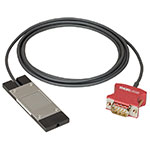 |
| Overall Dimensions | 76.0 mm x 25.2 mm x 5.0 mm (2.99" x 0.99" x 0.20") |
| Active Detector Area | 18 mm x 18 mm |
| Input Aperture | 20 mm x 20 mm |
| Wavelength Range | 350 - 1100 nm |
| Optical Power Working Range | 10 nW - 150 mW |
| Detector Type | Silicon Photodiode |
| Linearity | ±0.5% |
| Resolutionb | 1 nW |
| Calibration Uncertaintyc | ±3% (440 - 980 nm) ±5% (350 - 439 nm) ±7% (981 - 1100 nm) |
| Responsivityd (Click for Plot) | Raw Data |
| Neutral Density Filter | Reflective (OD 1.5) |
| Cable Length | 1.5 m |
| Mounting Thread | Universal 8-32 / M4 Tap, Post Not Included |
| Compatible Consoles | PM400, PM100D, PM100USB, PM100A, PM101A, and PM320E |
- Wavelength Range: 350 nm to 1100 nm
- Sensitive to Optical Powers from 10 nW to 150 mW
- Designed to Measure Optical Power at the Sample Plane of a Microscope
- Silicon Photodiode with Large 18 mm x 18 mm Active Area
- Sensor Housing Dimensions: 76.0 mm x 25.2 x 5.0 mm
- Index Matching Gel Utilized in Design to Prevent Internal Reflections
- Information Stored in Connector
- Sensor Data
- NIST- and PTB-Traceable Calibration Data
- Post Mountable via 8-32 (M4) Tap
The S170C Microscope Slide Power Sensor Head is a silicon photodiode sensor designed to measure the power at the sample in microscopy setups. The silicon photodiode can detect wavelengths between 350 nm and 1100 nm at optical powers between 10 nW and 150 mW. The sensor head's 76.0 mm x 25.2 mm footprint matches that of a standard microscope slide and is compatible with most standard upright and inverted microscopes.
The photodiode has an 18 mm x 18 mm active area and is contained in a sealed housing behind a neutral density (ND) filter with OD 1.5. A 20 mm x 20 mm indentation around the surface of the ND filter is sized to accept standard microscope cover slips. An immersion medium (water, glycerol, oil) may be placed in this well directly over the ND filter, or a cover slip may be inserted first to simplify clean up. The gap between the photodiode and the neutral density filter has been filled with an index matching gel in order to prevent internal reflections from causing significant measurement errors when using high NA objectives with oil or water.
The bottom of the sensor housing features a laser-engraved grid to aid in aligning and focusing the beam. In standard microscopes, this grid can be used for beam alignment before flipping the sensor head to face the objective for power measurements. In inverted microscopes, turn on the transmitted illuminator to align the grid on the detector housing with the beam, thereby centering the sensor in front of the objective. Alternatively, the diffusive surface of the ND filter can be used as a focusing plane.
Each sensor is shipped with NIST- or PTB-traceable calibration data. The included data will match the calibration certification of the photodiode used to test the individual sensor. Sensor specifications and the included NIST- or PTB-traceable calibration data are stored in non-volatile memory in the sensor connector and can be read out by the latest generation of Thorlabs power meters. We recommend yearly recalibration to ensure accuracy and performance. Calibration may be ordered using the CAL1 recalibration service available below. Please contact technical support for more information.
The complete set of specifications are presented on the Specs tab above. Thorlabs also offers a Microscope Slide Sensor Head with a thermal sensor; the full presentation can be found here.


Click to Enlarge
S142C and S140-BFA Bare Fiber Adapter (Sold Separately)

Click to Enlarge
S142C with the S120-FC Fiber Adapter (Included)
- For Measurements Independent of Beam Shape and Entrance Angle
- Integrating Sphere Design Acts as a Diffuser with Minimal Power Loss
- Ø5 mm, Ø7 mm, or Ø12 mm Input Sensor Aperture
- Removable S120-FC Fiber Adapter (FC/PC and FC/APC) Included
- Compatible Fiber Adapters for Terminated and Bare Fiber (See Table Below)
These Integrating Sphere Photodiode Power Sensors are the ideal choice for power measurements independent of beam uniformity, divergence angle, beam shape, or entrance angle, making them excellent for use with fiber sources and off-axis free space sources.
Our integrating spheres are designed for wavelength ranges from the visible through the NIR. Sensor heads for use between 350 and 2500 nm use a single Ø1" or Ø2" sphere made from Zenith® PTFE and feature a black housing to minimize reflected light around the entrance aperture. These sensors use either a silicon photodiode for detection in the 350 - 1100 nm range or an InGaAs photodiode for detection in the 800 - 1700 nm, 900 - 1650 nm, or 1200 - 2500 nm wavelength range.
The S180C integrating sphere for 2.9 - 5.5 µm uses two connected, gold-plated Ø20 mm spheres, with an entrance port in the first sphere and a port for the MCT (HgCdTe) detector located in the second sphere. Compared to single-sphere designs, the two-sphere configuration improves device sensitivity by minimizing the internal sphere surface area while still effectively shielding the detector from direct illumination. This design reduces the effect of input angle, divergence, and beam shape on the measurement result by effectively shielding the photodiode without the use of a baffle or other shielding mechanism.
The integrating spheres below feature large Ø5 mm, Ø7 mm, or Ø12 mm apertures, externally SM1-threaded (1.035"-40) front connections, enhanced shielding against electromagnetic interference, and an over-temperature alert sensor. Because of the large active detector areas of these sensors, the included S120-FC fiber adapter can be used with FC/PC- or FC/APC-terminated fiber. The externally SM1-threaded adapter can be removed using a size 1 screwdriver to place components closer to the window.
Each sensor is shipped with NIST- or PTB-traceable calibration data. The included data will match the calibration certification of the photodiode used to test the individual sensor. NIST- or PTB-traceable data is stored in the sensor connector. Thorlabs offers a recalibration service for these photodiode power sensors, which can be ordered below (see Item # CAL1 for Si sensors, Item # CAL2 for InGaAs sensors, and Item # CAL4 for InGaAs or MCT sensors).
| Item #a | S140C | S142C | S144C | S145C | S146C | S148C | S180C |
|---|---|---|---|---|---|---|---|
| Sensor Image (Click the Image to Enlarge) |
 |
 |
 |
 |
 |
 |
 |
| Aperture Size | Ø5 mm | Ø12 mm | Ø5 mm | Ø12 mm | Ø5 mm | Ø7 mm | |
| Wavelength Range | 350 - 1100 nm | 800 - 1700 nm | 900 - 1650 nm | 1200 - 2500 nm | 2.9 µm - 5.5 µm | ||
| Power Range | 1 µW - 500 mW | 1 µW - 5 W | 1 µW - 500 mW | 1 µW - 3 W | 10 µW - 20 W | 1 µW - 1 W | 1 µW - 3 W |
| Detector Type | Si Photodiode | InGaAs Photodiode | MCT (HgCdTe) Photodiode |
||||
| Linearity | ±0.5% | ||||||
| Resolutionb | 1 nW | 10 nW | 1 nW | 10 nW | |||
| Measurement Uncertaintyc |
±3% (440 - 980 nm) ±5% (350 - 439 nm) ±7% (981 - 1100 nm) |
±5% | |||||
| Responsivityd (Click for Plot) |
Raw Data |
Raw Data |
Raw Data |
Raw Data |
Raw Data |
Raw Data |
Raw Data |
| Integrating Sphere Material (Size) |
Zenith® PTFE (Ø1") |
Zenith® PTFE (Ø2") |
Zenith® PTFE (Ø1") |
Zenith® PTFE (Ø2") |
Zenith® PTFE (Ø1") |
Gold Plating (Two Ø20 mm Spheres) |
|
| Head Temperature Measurement |
NTC Thermistor 4.7 kΩ | ||||||
| Housing Dimensions |
Ø45 mm x 30.5 mm | 70 mm x 74 mm x 70 mm | Ø45 mm x 30.5 mm | 70 mm x 74 mm x 70 mm | Ø45 mm x 30.5 mm | 59.0 mm x 50.0 mm x 28.5 mm |
|
| Active Detector Area | 3.6 mm x 3.6 mm | Ø2 mm | Ø1 mm | Ø1 mm | 1 mm x 1 mm | ||
| Cable Length | 1.5 m | ||||||
| Mounting Thread | Separate 8-32 and M4 Taps, Posts Not Included | Universal 8-32 / M4 Tap, Post Not Included | |||||
| Aperture Thread | Included Adapter with SM1 (1.035"-40) External Thread | ||||||
| Compatible Fiber Adapters |
S120-FC (Included) S120-APC, S120-SMA, S120-ST, S120-SC, S120-LC, and S140-BFA (Not Included) |
||||||
| Compatible Consoles | PM400, PM100D, PM100USB, PM100A, PM101A, and PM320E | ||||||


- Compatible with S140C Series Power Sensors
- Power Measurements of Bare Fiber Outputs
- Easy Loading and Positioning of Optical Fiber in V-Groove
- Supports Fiber with Buffer Diameters from 250 to 450 µm
- Tight Holding without Fiber Damage by Magnetic Clip
- Attached by Two M2.5 x 4 mm Cap Screws


Click to Enlarge
PM100D with S150C Sensor and FC Cable
- For Fiber-Based Optical Power Measurements
- Compact Sensor Integrated into the Connector
- Integrated Design for use in the Field and Lab
- Includes FC/PC Adapter
- S150C and S151C Sensors also Include SMA Adapter
- Compatible FC/APC, LC/PC, SC/PC, and ST Fiber Adapters Also Available (See Table Below)
- Compatible with the PM100D, PM100USB, PM100A, and PM320E Consoles
The S15xC Compact Fiber Photodiode Power Sensor is designed to take power measurements from a wide variety of fiber-coupled sources. The compact sensor, integrated into the power meter connector, features a unique integrated design housing the photodiode sensor, fiber coupling, and NIST- or PTB-traceable data. The fiber adapter included with each sensor can be interchanged easily to accomodate a variety of fiber connectors (see table below).
Each sensor is shipped with NIST- or PTB-traceable calibration data. The included data will match the calibration certification of the photodiode used to test the individual sensor. NIST- or PTB-traceable data is stored in the sensor connector. Thorlabs offers a recalibration service for these photodiode power sensors, which can be ordered below (see Item # CAL1 for Si sensors and Item # CAL2 for InGaAs sensors).
| Item #a | S150C | S151C | S154C | S155C |
|---|---|---|---|---|
| Sensor Image (Click the Image to Enlarge) |
||||
| Wavelength Range | 350 - 1100 nm | 400 - 1100 nm | 800 - 1700 nm | |
| Power Range | 100 pW to 5 mW (-70 dBm to +7 dBm) |
1 nW to 20 mW (-60 dBm to +13 dBm) |
100 pW to 3 mW (-70 dBm to +5 dBm) |
1 nW to 20 mW (-60 dBm to +13 dBm) |
| Detector Type | Si Photodiode | InGaAs Photodiode | ||
| Linearity | ±0.5% | |||
| Resolutionb | 10 pW (-80 dBm) | 100 pW (-70 dBm) | 10 pW (-80 dBm) | 100 pW (-70 dBm) |
| Measurement Uncertaintyc | ±3% (440 - 980 nm) ±5% (350 - 439 nm) ±7% (981 - 1100 nm) |
±3% (440 - 980 nm) ±5% (400 - 439 nm) ±7% (981 - 1100 nm) |
±5% | |
| Responsivityd (Click for Details) | Raw Data |
Raw Data |
Raw Data |
Raw Data |
| Coating/Diffuser | N/A | Absorptive ND (Schott NG3) | N/A | |
| Head Temperature Measuremente | NTC Thermistor 3 kΩ | |||
| Aperture Thread | External SM05 (0.535"-40) | |||
| Fiber Adaptersf | Included (FC and SMA): PM20-FC and PM20-SMA; Optional: PM20-APC, PM20-LC, PM20-SC, and PM20-ST |
Included (FC): PM20-FC; Optional: PM20-APC, PM20-LC, PM20-SC, PM20-ST, and PM20-SMA |
||
| Compatible Consoles | PM400, PM100D, PM100USB, PM100A, PM101A, and PM320E | |||

These internally SM05-threaded (0.535"-40) adapters mate terminated fiber to our free-space detectors and power sensors, including, but not limited to:
- S150C Series Fiber Power Meter Sensors (Sold Above)
- PM160 Series Wireless, Handheld Power Meter
- PM20 Series Fiber Power Meters
For details on narrow versus wide key connectors, please see our Intro to Fiber tutorial. Please contact Tech Support if you are unsure if the adapter is mechanically compatible.

These internally SM1-threaded (1.035"-40) adapters mate terminated fiber to any of our externally SM1-threaded components, including a selection of our photodiode power sensors, our thermal power sensors, and our photodetectors.
The APC adapters have two dimples in the front surface that allow them to be tightened with the SPW909 or SPW801 spanner wrench. The dimples do not go all the way through the disk so that the adapter can be used in light-tight applications when paired with SM1 lens tubes.
For details on narrow versus wide key connectors, please see our Intro to Fiber tutorial. Please contact Tech Support if you are unsure if the adapter is mechanically compatible.


Click to Enlarge
SM1 Lens Tube Mounted on an S132C Photodiode Sensor Using an SM1A29 Adapter
- Compatible with Thorlabs Slim Photodiode Power Sensors
- Enables Integration with SM1-Threaded Components
- Adds VIS/IR Target Around Sensor
The SM1A29 adapter can be attached to our slim photodiode sensors using two setscrews, which are compatible with 0.035" (0.9 mm) hex keys. This allows for mounting SM1-threaded fiber adapters, filters, or other SM1-threaded mechanics or optics to our slim photodiode sensors. The target around the aperture uses the same material as our VRC2 Laser Viewing Card and is sensitive to light between the wavelength ranges of 400 - 645 nm and 800 - 1700 nm.


Click for Details S130C Photodiode Sensor Mounted in FiberBench System Using FBSM Adapter
- Compatible with Thorlabs Slim Photodiode Power Sensors
- Enables Integration with Single- and Multi-Axis FiberBench Systems
- Adds VIS/IR Target Around Sensor
The FBSM FiberBench Mount enables stable mounting of our slim photodiode sensors into our FiberBench systems. A side-located setscrew with a 0.050" (1.3 mm) hex can be used to lock the sensor in place. The mount has dowel pins for compatibility with FiberBenches and an optical axis height of 0.56" (14.2 mm) to match other FiberBench components. The target around the aperture uses the same material as our VRC2 Laser Viewing Card and is sensitive to light between the wavelength ranges of 400 - 645 nm and 800 - 1700 nm.

| Calibration Service Item # | Compatible Sensors |
|---|---|
| CAL1 | S120VC, S120C, S121C, S170C, S140C, S142C, S150C, S151C |
| CAL2 | S122C, S144C, S145C, S146C, S154C, S155C |
| CAL-S130 | S130VC, S130C |
| CAL-S132 | S132C |
| CAL4 | S148C, S180C |
Thorlabs offers calibration services for our photodiode optical power sensors and consoles. To ensure accurate measurements, we recommend recalibrating the sensors annually. Recalibration of the console is included with the recalibration of a sensor at no additional cost. If you wish to recalibrate only your power meter console, please contact Tech Support for details.
Refer to the table to the right for the appropriate calibration service Item # that corresponds to your power meter sensor. Once the appropriate Item # is selected, enter the Part # and Serial # of the sensor that requires recalibration prior to selecting Add to Cart.
 Products Home
Products Home




























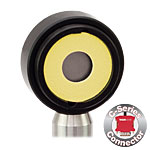
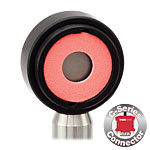
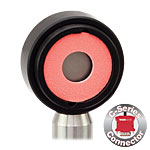
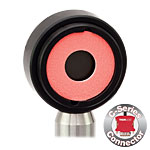


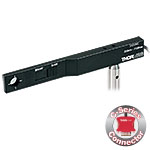

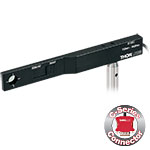
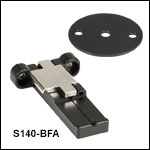
 Zoom
Zoom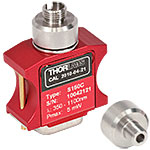
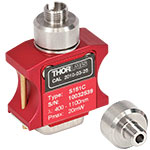
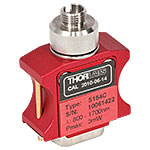

















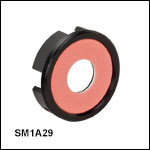
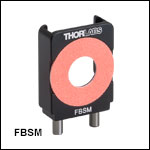
 Photodiode Power Sensors
Photodiode Power Sensors